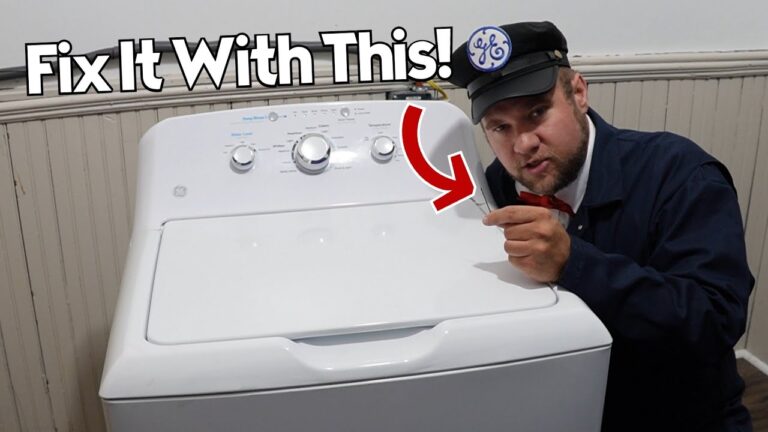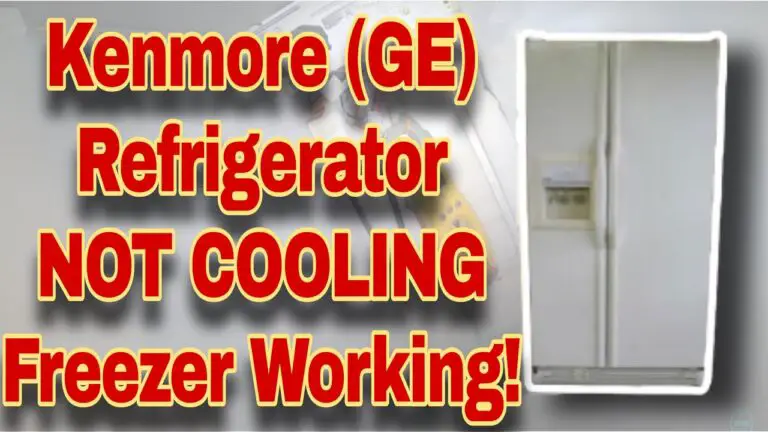GE Profile Oven Troubleshooting: Quick Fixes and Tips
To troubleshoot a GE Profile oven, check the power source and ensure the control panel is functioning correctly. Refer to the user manual for detailed instructions.GE Profile ovens are reliable, but occasional issues can arise. Troubleshooting common problems can save time and avoid costly repairs. Start by verifying the power supply and control panel. These components often cause issues. Understanding how to address minor problems will help maintain your oven’s performance.
Following simple troubleshooting steps can resolve many issues. Always consult the user manual for guidance tailored to your specific model. Proper care and maintenance ensure your GE Profile oven continues to perform efficiently. Keep reading to explore more detailed troubleshooting tips and solutions for common oven problems.
Common Issues
Dealing with oven problems can be frustrating. But don’t worry, many issues are easy to fix. Below, we cover some common problems with GE Profile ovens.
Oven Not Heating
One common issue is the oven not heating. This can be due to various reasons:
- Faulty heating element: Check if the heating element is working. If not, replace it.
- Blown fuse: Inspect the fuse and replace if blown.
- Thermostat issues: Ensure the thermostat is set correctly.
To check the heating element, follow these steps:
- Turn off the oven and unplug it.
- Locate the heating element inside the oven.
- Use a multimeter to test for continuity.
- If there’s no continuity, replace the heating element.
If the problem persists, consider consulting a professional technician.
Oven Door Won’t Close
An oven door that won’t close can be annoying. Here are a few things to check:
- Door latch: Make sure the door latch is not broken or stuck.
- Hinges: Inspect the hinges for any damage or misalignment.
- Seals: Check the door seals for wear and tear.
To fix door latch issues:
- Turn off the oven and unplug it.
- Inspect the latch for any visible damage.
- If damaged, replace the latch with a new one.
For hinge problems:
- Turn off the oven and unplug it.
- Remove the oven door from its hinges.
- Inspect the hinges for bends or breaks.
- Replace any damaged hinges.
Following these tips should help resolve the issue. If not, professional help may be needed.

Error Codes
Encountering error codes on your GE Profile Oven can be frustrating. These codes indicate specific problems that need attention. Understanding and resolving these codes can save you time and money.
Understanding Error Codes
GE Profile Ovens display error codes to highlight issues. Each code corresponds to a particular problem. Below is a list of common error codes and their meanings:
| Error Code | Description |
|---|---|
| F0 | Stuck keypad |
| F1 | Defective touchpad or control board |
| F2 | Oven temperature too high |
| F3 | Oven temperature sensor issue |
| F4 | Shorted temperature sensor |
Resetting The Oven
Resetting your oven can sometimes clear error codes. Follow these steps to reset your GE Profile Oven:
- Turn off the oven.
- Unplug it from the power source.
- Wait for at least 5 minutes.
- Plug the oven back in.
- Turn the oven on.
This simple reset can often resolve minor issues. If the error persists, professional assistance may be needed.
Cleaning And Maintenance
Keeping your GE Profile Oven in top condition ensures its longevity and performance. Proper cleaning and maintenance routines help avoid common issues. Here’s how you can maintain your oven with ease.
Self-cleaning Feature
The GE Profile Oven comes with a handy self-cleaning feature. This feature saves time and effort. Follow these steps to use it:
- Remove all racks and accessories from the oven.
- Close the oven door securely.
- Select the “Self-Clean” option on the control panel.
- Choose the cleaning duration (2, 3, or 4 hours).
- Press “Start” to begin the self-cleaning cycle.
During the cycle, the oven will heat to high temperatures. This burns off any residue inside. Ensure the kitchen is well-ventilated.
Manual Cleaning Tips
For areas the self-cleaning feature can’t reach, manual cleaning is necessary. Here are some manual cleaning tips:
- Use a soft cloth or sponge with mild detergent.
- Avoid abrasive cleaners or scouring pads.
- Clean the oven door with a glass cleaner for a streak-free shine.
- Remove racks and soak them in warm, soapy water.
- Use a non-abrasive scrubber to remove baked-on food.
Regular maintenance helps keep your GE Profile Oven efficient. Follow these tips to ensure your oven remains clean and in good working order.
Temperature Problems
Experiencing temperature issues with your GE Profile Oven? This can be frustrating. Cooking and baking require precise temperatures for the best results. Let’s dive into common temperature problems and how to fix them.
Inaccurate Temperature
Inaccurate oven temperatures can ruin your meals. Incorrect heating is a major issue. It can cause undercooked or overcooked food. Check the oven’s temperature settings first. You may notice the oven doesn’t reach the set temperature.
| Possible Causes | Solutions |
|---|---|
| Faulty Thermostat | Replace the thermostat |
| Heating Element Issues | Inspect and replace heating elements |
| Door Seal Problems | Replace damaged door seals |
Calibrating The Oven
Calibration ensures your oven heats accurately. Follow these simple steps to calibrate:
- Set the oven to 350°F. Use an oven thermometer to check the actual temperature.
- If the temperature is off, adjust the oven settings. This is usually done through the oven’s control panel.
- Refer to your oven’s manual for specific calibration instructions. Each model may vary.
Calibration might need repeating. Make small adjustments for the best results.
Control Panel Issues
The control panel is the brain of your GE Profile Oven. Problems here can make your oven unusable. Let’s dive into common control panel issues.
Unresponsive Buttons
Unresponsive buttons can be frustrating. First, check if the oven is getting power. Look at the circuit breaker and ensure it is on. If the oven has power, but the buttons do not work, you may need to clean them.
Cleaning the buttons can help. Use a soft cloth and mild cleaner. Gently wipe the buttons. Do not use too much water. Let the panel dry completely. If the buttons still do not work, you may need to reset the oven.
To reset the oven, turn off the circuit breaker for five minutes. Turn it back on. This can solve minor electronic issues. If the buttons remain unresponsive, the control panel might be faulty.
Replacing The Control Panel
Sometimes, the control panel needs replacing. This can be done at home, but it requires care. First, ensure the oven is off. Unplug it from the power source. If it is hard-wired, turn off the breaker.
Gather your tools. You will need a screwdriver, pliers, and the new control panel. Follow these steps:
- Remove the screws from the back of the control panel.
- Carefully pull the panel forward.
- Disconnect the wires attached to the old panel.
- Attach the wires to the new panel.
- Secure the new panel with screws.
Test the new control panel. Plug the oven back in or turn on the breaker. Check if the buttons respond. If they do, the replacement was successful. If not, there may be a deeper issue.
You can also contact a professional if you are unsure. They can diagnose and fix complex problems.

Electrical Problems
Having issues with your GE Profile Oven can be frustrating. Electrical problems are common but fixable. This guide helps you troubleshoot electrical problems step by step.
Checking Power Supply
First, check the power supply. Ensure the oven is plugged in correctly. Sometimes, a loose plug can cause problems. Verify the outlet is working by plugging in another device. If the device works, the outlet is fine.
Next, check the circuit breaker. Locate your home’s breaker box. Find the switch labeled for the oven. If it’s flipped, switch it back on. This can reset the power supply to your oven.
Inspecting Fuses
Inspect the fuses in your oven. Some ovens have internal fuses that can blow. Refer to your oven’s manual to locate these fuses.
Use a multimeter to test the fuse. Set the multimeter to the continuity setting. Place the probes on each end of the fuse. If the reading is zero, the fuse is good. If not, replace the fuse.
Replace any blown fuses with the correct type. Using the wrong fuse can cause more problems. Always refer to your manual for the correct type.
| Problem | Possible Cause | Solution |
|---|---|---|
| Oven not heating | Power supply issue | Check power outlet and circuit breaker |
| Oven display not working | Blown fuse | Inspect and replace fuse |
Door Seal Issues
A faulty door seal can cause many problems with your GE Profile oven. The door seal keeps heat inside the oven. If the seal is broken, heat escapes. This can lead to longer cooking times and uneven cooking. Fixing the door seal is important for your oven’s efficiency.
Replacing The Door Seal
Replacing the door seal is a simple process. First, ensure the oven is off and cool. Next, open the oven door and locate the old seal. It runs along the edge of the oven door.
Carefully remove the old seal. You might need to use a tool to pry it off. Once removed, clean the area to remove any debris.
Now, take the new door seal. Align it with the edge of the door. Press it firmly into place. Make sure it fits snugly.
Ensuring Proper Fit
Ensuring the door seal fits properly is crucial. A loose seal will not trap heat effectively. After installing the new seal, close the oven door. Check for any gaps between the door and the oven frame.
If you see gaps, adjust the seal. Press it more firmly into place. Sometimes, you might need to remove and reapply the seal.
Also, test the seal by turning on the oven. Let it heat up. Feel around the door for any escaping heat. If you find leaks, adjust the seal again.
| Step | Description |
|---|---|
| Step 1 | Turn off and cool the oven |
| Step 2 | Remove the old seal |
| Step 3 | Clean the area |
| Step 4 | Install the new seal |
| Step 5 | Ensure proper fit |
Follow these steps to fix your oven door seal. This will improve your oven’s performance.
When To Call A Professional
Experiencing issues with your GE Profile oven can be frustrating. While some problems can be solved with simple troubleshooting, others require professional assistance. Knowing when to call a professional can save you time and prevent further damage to your oven.
Identifying Major Issues
Some issues are too complex for DIY fixes. Here are some major issues:
- Oven not heating: If your oven doesn’t heat, call a technician.
- Strange noises: Hearing unusual sounds? This might need expert help.
- Error codes: Error codes on the display often require professional diagnosis.
- Electrical problems: Smelling burning wires? Turn off the oven and call a pro.
Choosing A Reliable Technician
Not all technicians are the same. Follow these tips to choose the right one:
- Check credentials: Ensure the technician is certified and experienced.
- Read reviews: Look for positive feedback from other customers.
- Ask for references: A good technician will have happy clients.
- Compare costs: Get quotes from multiple professionals to find a fair price.
Use these tips to ensure your GE Profile oven gets the best care possible.
Frequently Asked Questions
How Do I Reset My Ge Oven Profile?
To reset your GE oven profile, press the “Clear/Off” button. Hold for 10 seconds until the display resets.
Why Is My Ge Profile Oven Not Working?
Your GE Profile oven might not work due to a blown fuse, tripped circuit breaker, or faulty control board. Check power connections and reset the oven.
Why Is My Ge Oven Not Heating The Correct Temperature?
Your GE oven may not heat correctly due to a faulty temperature sensor, heating element, or calibration issues. Check connections and settings.
Where Is The Fuse On A Ge Profile Range?
The fuse on a GE Profile range is typically located behind the control panel or near the oven’s back. Check your user manual for exact placement. Always unplug the range before inspecting.
How Do I Reset My Ge Profile Oven?
To reset, turn off the power at the circuit breaker, wait 5 minutes, then turn it back on.
Conclusion
Troubleshooting your GE Profile Oven can be straightforward with the right guidance. Follow the steps provided to resolve common issues. Regular maintenance can prevent many problems. Always consult the manual or a professional for complex issues. Your oven should function smoothly, ensuring delicious meals every time.





